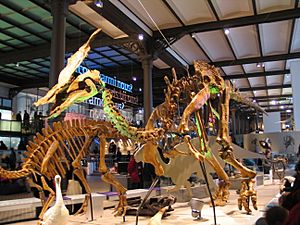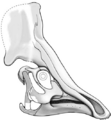Olorotitan facts for kids
Olorotitan was a fascinating type of dinosaur that lived millions of years ago. It was a large plant-eating dinosaur known for its unique head crest and long neck. This amazing creature roamed the Earth during the very end of the Cretaceous period.
Contents
About Olorotitan
What Was Olorotitan?
Olorotitan was a hadrosaurid, also known as a "duck-billed dinosaur." These dinosaurs are famous for their wide, flat snouts that look a bit like a duck's bill. Olorotitan was part of a group called Lambeosaurinae. This group is special because its members had hollow crests on their heads.
The name "Olorotitan" means "giant swan." This name was chosen because of its unusually long neck. It was longer than the necks of most other duck-billed dinosaurs.
Where Did Olorotitan Live?
Olorotitan lived in what is now the Far East of Russia. Its fossils were found in the Amur Region. This area was likely a lush, warm environment during the Late Cretaceous period. It had many plants for these large herbivores to eat.
When Did Olorotitan Live?
This dinosaur lived during the very end of the Cretaceous period. This was about 68 to 66 million years ago. It was one of the last non-bird dinosaurs to exist before the big extinction event. This event wiped out most dinosaurs.
How Big Was Olorotitan?
Olorotitan was a very large dinosaur. Scientists estimate it could grow up to 8 to 12 meters (about 26 to 39 feet) long. That's roughly the length of a school bus! It would have been quite heavy too, weighing several tons. Its size helped it reach tall plants and protect itself from predators.
What Did Olorotitan Eat?
Like all hadrosaurids, Olorotitan was a herbivore. This means it ate only plants. Its duck-like bill was perfect for snipping off leaves and twigs. It also had hundreds of small, grinding teeth in its cheeks. These teeth helped it chew tough plant material. It likely ate ferns, conifers, and flowering plants.
Its Unique Crest
One of the most striking features of Olorotitan was its large, hollow crest. This crest rose high above its head. Scientists believe these crests were used for several things. They might have helped the dinosaurs make loud sounds, like a trumpet. This would have been useful for communicating with other Olorotitan dinosaurs. They could have warned about danger or called to mates. The crest also might have been used for display. This means it could have helped Olorotitan recognize others of its kind or attract a mate.
Discovery of Olorotitan
The first fossils of Olorotitan were discovered in the Udurchukan Formation in Russia. The dinosaur was officially described and named in 2003 by a paleontologist named Pascal Godefroit. The discovery of a nearly complete skeleton helped scientists learn a lot about this unique dinosaur. It showed how diverse and interesting the duck-billed dinosaurs were.
Images for kids
-
Fossils of the holotype specimen in situ
-
Restoration of Olorotitan and Charonosaurus in their environment
See also
 In Spanish: Olorotitan arharensis para niños
In Spanish: Olorotitan arharensis para niños







